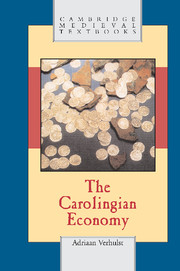8 - Money and price movements
Published online by Cambridge University Press: 05 June 2012
Summary
MONETARY HISTORY
Before addressing the general and difficult problem of the use of money under the Carolingians the strict monetary history of their reign will be summarised in order to put the facts before their interpretation.
In 754–5, soon after his accession to the throne as king, Pipin III restored the standard weight of the silver denier, which had progressively replaced the gold tremissis during the last decades of the seventh century, from 1.1 g to 1.3 g. Charlemagne during the first decades of his reign, from 768 to 793–4, did not innovate and maintained this weight, only reducing the number of mints to about forty. Apart from changes of the obverse and reverse of coins in 806, adapting them to Charles' imperial status, the only monetary reform of his reign until his death in 814 was in the winter of 793–4, when he increased the weight of the denier from 1.3 g to 1.7 g. The introduction of a heavy denier was not easily accepted by the public because it favoured the creditors at the expense of the debtors whose fixed obligations, for example as rentpayers, were apparently not changed. The explanation of what looks like a compensation for a lower silver price has been sought by Grierson, Doehaerd, Bolin, Lombard and others in the international relations of the Carolingian empire, particularly in the evolution of the relation of gold to silver in the east–west export trade.
- Type
- Chapter
- Information
- The Carolingian Economy , pp. 117 - 125Publisher: Cambridge University PressPrint publication year: 2002



